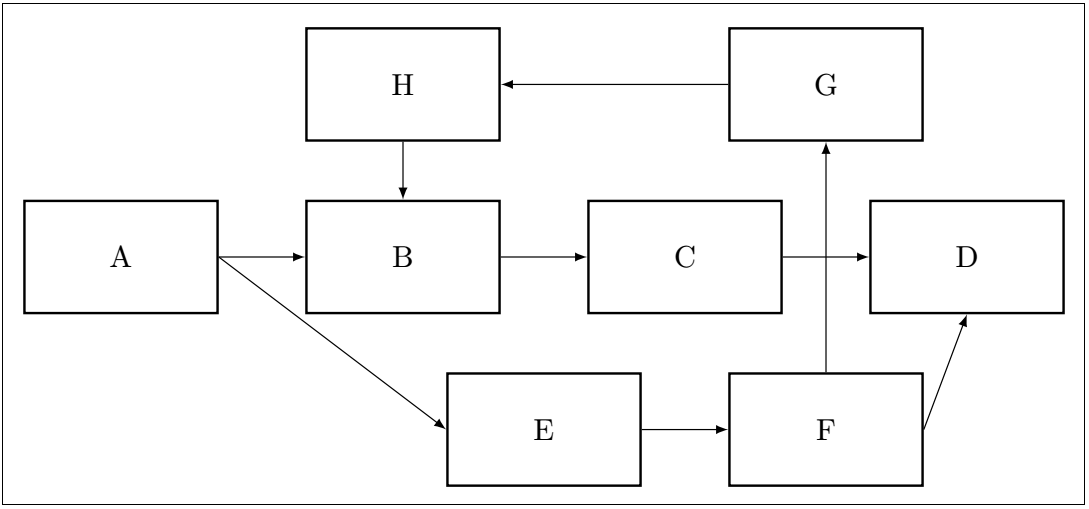📌 相关文章
- 使用Tikz的 latex 节点图(1)
- 使用Tikz的 latex 节点图
- 使用Tikz的 latex 条形图和饼图
- 使用Tikz的方程的 latex 图(1)
- 使用Tikz的方程的 latex 图
- 使用Tikz的 latex 流程图(1)
- 使用Tikz的 latex 流程图
- 线框图(1)
- 线框图
- 如何使用Latex
- 如何使用Latex(1)
- latex 图
- latex 图
- c# latex - C# (1)
- latex表
- LateX (1)
- 控制系统-框图
- 控制系统-框图(1)
- Matplotlib-3D线框图
- Matplotlib-3D线框图(1)
- tikz 独立图片 (1)
- tikz 绘制虚线 (1)
- c# latex - C# 代码示例
- tikz 独立图片 - 任何代码示例
- tikz 绘制虚线 - 任何代码示例
- 日期的数据框图分布 - Python (1)
- Material-ui 添加框图标 - Javascript(1)
- 日期的数据框图分布 - Python 代码示例
- Material-ui 添加框图标 - Javascript代码示例
📜 使用Tikz的 latex 框图
📅 最后修改于: 2021-01-06 00:49:50 🧑 作者: Mango
使用TikZ的框图
Tikz被定义为用于从代数或几何描述生成矢量图形的一对语言。流行的Tikz环境也用于Latex宏程序包。 Tikz解释器在后端支持多个Tex输出。以下是用于创建块的一些命令:
- \ node命令用于绘制块并提及块的位置。
- \ draw命令用于绘制线条的不同样式。
- \ tikzset命令用于设置块的规格。
- \ usetikzlibrary是用于在程序中实现定位系统的库。
Tikz环境写为:
\begin{tikzpicture}
.....
\end{tikzpicture}
让我们以模拟通信系统的框图为例。下面给出了使用Tikz创建简单块结构的代码:
\documentclass[tikz,border=4mm]{standalone} % specifies the border
\usetikzlibrary{positioning,fit,calc} % used for the efficient working of the positioning system
\tikzset{block/.style={draw, thick, text width=3cm, minimum height=1.5cm, align=center},
% the align command is used to align the block diagram at the center
% the height command adjust the height of the block diagram
% here block diagram refers to the whole diagram, not the single block
% the thick command here signifies the border of all the blocks used inside the block diagram. You can change it to thin command if you want the thin edge of the blocks
line/.style={-latex} % the lesser the width the greater will be the diagram window
}
\begin{document}
\begin{tikzpicture}
\node[block] (a) {Source};
\node[block,right=of a] (b) {Transmitter}; % these are the name of the blocks
% you can use as many blocks by specifying the name and alphabets
\node[block,right=of b] (c) {Channel};
\node[block,right=of c] (d) {Reciever};
\node[block,right=of d] (e) {Destination};
\node[block] (f) at ([yshift=-3cm]$(b)!1.0!(c)$) {Noise};
% the yshift here specifies the shift in the position of the point on the y-axis. You can change the location according to the requirements.
% the value mentioned is the distance from (b) to (c). If the value is 0.5, then the block will be at the center of (b) and (c).
\node[draw,inner xsep=4mm,inner ysep=7mm,fit=(a)(b),label={100:P}](g){}; % it is used to draw the box outside the combination of blocks. Here a block will be drawn outside the block (a) and (b). The xsep and ysep are the dimensions for the box. The label command here is used to set the location of the name of the outer A and B blocks.
\node[draw,inner xsep=4mm,inner ysep=7mm,fit=(d)(e),label={80:Q}]{};
\draw[line] (a)-- (b);
\draw[line] (b)-- (c);
\draw[line] (f) -- (c); % you can change the location of the line to north, west, etc. depending on your requirements.
\draw[line] (c)-- (d); % -- signifies the line between the two blocks (c) and (d).
\draw[line] (d)-- (e);
\end{tikzpicture}
\end{document}
%之后写的文字只是为了使您更好地理解。 Latex忽略%字符后面的字符。
输出还将以默认的灰色背景色显示。
输出:

其他复杂的示例使用与上述相同的命令。
此类示例的代码如下:
\documentclass[tikz, border=5mm]{standalone}
\usetikzlibrary{positioning, fit, calc}
\tikzset{block/.style={draw, thick, text width=2cm ,minimum height=1.3cm, align=center},
line/.style={-latex}
}
\begin{document}
\begin{tikzpicture}
\node[block] (a) {A};
\node[block,right=of a] (b) {B};
\node[block,right=of b] (c) {C};
\node[block,right=of c] (d) {D}; % the commands used for the different location of different blocks
\node[block] (e) at ([yshift=-2cm]$(b)!0.5!(c)$) {E};
\node[block] (f) at ([yshift=-2cm]$(c)!0.5!(d)$) {F};
\node[block] (g) at ([yshift=2cm]$(c)!0.5!(d)$) {G};
\node[block] (h) at ([yshift=2cm]$(b)!1.0!(b)$) {H};
\draw[line] (a)-- (b);
\draw[line] (b)-- (c);
\draw[line] (c)-- (d);
\draw[line] (e)-- (f);
\draw[line] (g)-- (h);
\draw[line] (f)-- (g);
\draw[line] (a.east) -- (e.west);
\draw[line] (h)-- (b);
\draw[line] (f.east) -- (d.south);
\end{tikzpicture}
\end{document}
使用的命令简单易懂,易于实现。
输出:

您可以根据要求绘制任何形式的框图。
颜色填充
您也可以在特定框图的块中填充颜色。我们来看一个例子:
\documentclass[tikz, border=5mm]{standalone}
\usetikzlibrary{positioning, fit, calc}
\usepackage{xcolor}
\tikzset{block/.style={draw, thick, text width=2cm , minimum height=1.3cm, align=center},
line/.style={-latex}
}
\begin{document}
\begin{tikzpicture}
\node[block, fill=olive] (a) {A};
\node[block,right=of a, fill=yellow] (b) {B};
\node[block,right=of b, fill= gray] (c) {C};
\node[block, fill=purple] (d) at ([yshift=-2cm]$(a)!0.5!(b)$) {D};
\node[block, fill= orange] (e) at ([yshift=-2cm]$(b)!0.5!(c)$) {E};
\node[draw, fill=pink, fill opacity=0.5,inner xsep=5mm,inner
ysep=6mm,fit=(d)(e),label={130:A}](f){}; % here label command is used to label the block, which covers block D and E.
\draw[line] (a)-- (b);
\draw[line] (b)-- (c);
\draw[line] (d)-- (e);
\draw[line] (e)-- ($(b)!0.5!(c)$);
\draw[line] (d)-- ($(a)!0.5!(b)$);
\end{tikzpicture}
\end{document}
在这里,我们为所有块着色。您可以根据需要修改颜色。您还可以根据要求为全部或部分块着色。
输出:
